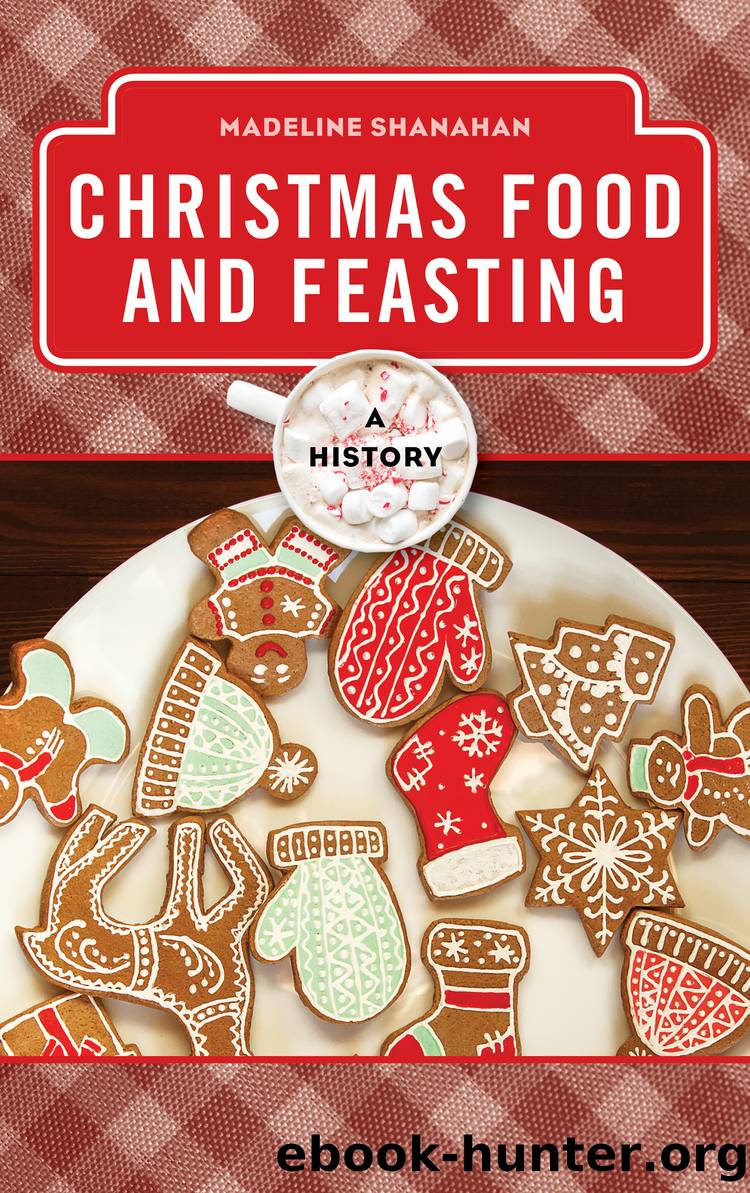Christmas Food and Feasting by Madeline Shanahan

Author:Madeline Shanahan [Shanahan, Madeline]
Language: eng
Format: epub
Publisher: Rowman & Littlefield Publishers
Published: 2019-01-28T00:00:00+00:00
âParkâs New Twelfth Night Characters.â
Copyright 2018, Hordern-Dalgety Collection. http://puzzlemuseum.org.
Christmas Cake
From the second half of the nineteenth century, the Twelfth cake went into decline in Britain, and soon it was relegated to the dining halls of Christmas past. Today, at least in most of the English-speaking world, very few people have heard of Twelfth cake, let alone eaten it or participated in a wild game of festive role-play. Given its huge cultural significance in the past, this relatively rapid descent into culinary oblivion is remarkable. The British Christmas has not been left cakeless, though. The void that was left was filled by Christmas cake: similar to the Twelfth cake in so many ways, but regrettably less fun. Like its predecessor, Christmas cake is a rich fruitcake, and it is often elaborately iced and decorated. Unlike the Twelfth cake, though, it is not associated with any specific day in the festival, and it does not have any ritualized games or activities surrounding it. Rather than being the centerpiece of a wild night of frivolities in which the social order is upended, Christmas cake is quite simply there to sit on the sideboard looking cheerful and to be offered to guests with a cup of tea. So, while it inherited aspects of Twelfth cakeâs legacy, it did not assume many of its most defining elements. Some of these traditions, such as role-play and, indeed, the celebration of Twelfth Night, largely disappeared, while other elements were subsumed into the rituals of other Christmas foods. For example, the fortune-telling trinkets did not disappear altogether but went into the plum pudding, and the corny jokes and mock crowns found their way into the Christmas crackers (see chapter 5).42
It is difficult to pinpoint the exact reason for Twelfth cakeâs decline and its replacement with a considerably more sedate descendant. Helen Leach, Mary Browne, and Raelene Inglis argue that the Twelfth cakeâs reputation had been irreversibly damaged after a series of widely reported scandals that tarnished its image. As discussed above, confectioners began to use toxic substances in their decorations, and a number of children died as a consequence of eating tainted cakes.43 The most obvious and convincing reason for the demise of the Twelfth cake, though, is quite simply the demise of Twelfth Night itself in Britain. As chapter 1 discussed, as Christmas Day rose in prominence over the course of the Victorian period, it absorbed many of the rituals of the traditional twelve days. The festival contracted and many traditions were lost altogether, while others were welded onto 25 December. This meant that the Christmas cake took on the primary culinary responsibilities of the Twelfth cake, but as the Epiphany itself was no longer widely marked outside the church, elements such as the bean king, Lord of Misrule, and character cards simply disappeared.
The transition from Twelfth cake to Christmas cake was not immediate, though, and there was a period of overlap in which the two coexisted. Leach, Browne, and Inglis have traced some of
Download
This site does not store any files on its server. We only index and link to content provided by other sites. Please contact the content providers to delete copyright contents if any and email us, we'll remove relevant links or contents immediately.
Machine Learning at Scale with H2O by Gregory Keys | David Whiting(4094)
Never by Ken Follett(3758)
Fairy Tale by Stephen King(3192)
The Man Who Died Twice by Richard Osman(2977)
Will by Will Smith(2766)
Friends, Lovers, and the Big Terrible Thing by Matthew Perry(2097)
The Becoming by Nora Roberts(2058)
A Short History of War by Jeremy Black(1743)
Go Tell the Bees That I Am Gone by Diana Gabaldon(1668)
515945210 by Unknown(1582)
A Game of Thrones (The Illustrated Edition) by George R. R. Martin(1563)
443319537 by Unknown(1450)
The 1619 Project by Unknown(1363)
Works by Richard Wright(1247)
Meditations (Modern Library) by Marcus Aurelius(1228)
Going There by Katie Couric(1139)
472244821 by Unknown(1129)
book title by 2023(1082)
264099364 by Unknown(1041)
